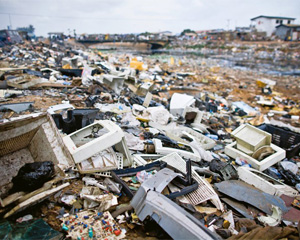Why America Needs A Stronger Policy On E-Recycling?

A recent report on e-waste recycling reveals the production, collection and export of used electronics in different countries. The report discloses some critical facts concerning the share of countries in generating and recycling the e-waste.
The report is compiled by StEP (Solving the E-Waste Problem), an initiative of the United Nations University. The report throws light on the leading countries that produce, collect and export used electronics. According to the report, America is currently the biggest party in global e-waste. The report also indicates the most common electronics in USA that go into the waste.
The results show some vital information on how the progressive society of America is causing global e-waste. Let’s have a look into this infographic published on www.livescience.com and check out the statistics:
Total E-Waste Produced In The Year 2012:
The infographic illustrates the total e-waste in millions of tons. According to the available data, the major parties globally produced 39.524 millions of tons of e-waste in 2010. Of this total value, European Union holds the highest disposal of e-waste (10.933) followed by United States of America (10.317) and China (7.995), while the India (3.033), Japan (3.022), Russia (1.556), Brazil (1.530) and Mexico (1.138) constitute the remaining 10.279 millions of tons of the e-waste. From this data, we can deduce that America alone makes up more than the total amount of e-waste produced by these five countries other than the European Union and China.
Total Used Electronics Generated In the United States:
The study further points out that America produced 258.2 million units of used electronics in a single year of 2010. Out of this total value, 171.4 millions of the used electronics is collected by the recyclers. This value gets further narrowed down for the export process and only 14.4 million of the second-hand electronics arrive at the developing countries. Overall, we can conclude that a relatively lesser percentage (66%) of e-waste goes into the recycling process.
Electronic Equipments Produced and Recycled in the United States:
The infographic further demonstrates the type of electronic equipments produced and recycled in America. The list shows that 33.141 million units of TV sets are thrown away, while the 16.879 (51%) of them reaches the recycling facility. Computers come next on the list as 29.902 millions of units are produced, while 22.171 (74%) of them go through the recycling process. Monitors and LCDs rank third on the list as they constitute the 17.671 million units, while the 12.768 (72%) of them are collected by the recyclers. And last but not the least, Americans produce 176.057 millions of units of mobile phones, while the 119.484 (68%) of them are collected. On the whole, we can conclude that computers are the most recycled electronic item in this list due to the fact that they are widely used in the America.
Conclusion
Finally, we can establish from the available data that the United States of America which is a leading producer of electronic gadgets and gizmos is also a key party in the e-waste produced in the world. According to the available findings, mobile phones top the list in the e-waste production. Nonetheless, only 68% of them are recycled which makes it the second least recycled electronic item in the America. However, the surprising fact is the recycling trend of TV sets. In spite of being the second most produced e-waste in USA, only 51% of the TV sets were recycled in the year 2010. However, computers and monitors maintain a decent percentage here with 74% and 72% respectively. This might relate to the growing trend of used computers and monitors in the developing countries.
Overall, we can say that a more comprehensive policy is needed to ensure safe recycling of electronics in the United States of America who is a key stake holder in the vision for an eco-friendly Earth.
About The Author Kelly Sampson
Kelly Sampson is a writer, blogger, and environmental enthusiast. She has strong opinions about climate change, the dogs vs. cats debate, and Oxford commas. She has lent Hummingbird International her engaging and spirited voice and turned our blog into a great place to find valuable information about e-waste, e-waste recycling, and the ITAD industry. Explore our blog to read more of her work.







